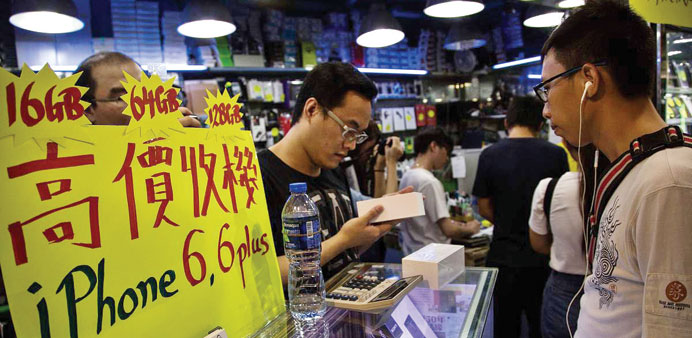People buying iPhone 6 units during its launch in Hong Kong. Apple said it sold 61.2mn iPhones in the three months ended March 28, up 40% from year earlier as sales jumped 72% in Hong Kong and Taiwan.
Dow Jones/Beijing
Apple Inc’s surging smartphone sales in China may have busted a myth: that many Chinese consumers couldn’t, or wouldn’t, shell out for an iPhone.
The tech giant cited sales of its latest smartphone as the driver behind its rising earnings announced on Monday. Apple said it sold 61.2mn iPhones in the three months ended March 28, up 40% from year earlier. The biggest growth came in greater China, which includes Hong Kong and Taiwan, where sales jumped 72% in that quarter.
Is this new evidence pointing to the arrival of China’s burgeoning middle class?
Until recently, sceptical analysts had described China as a challenging market for Apple. They said cost-conscious consumers were increasingly turning to local brands like Xiaomi that offer high-end features at much lower prices than the iPhone.
Other analysts argue the overall environment in China may be changing in favour of Apple, with average monthly salaries and disposable income continuing to increase in major cities despite the country’s slowing economic growth. Strong sales of the new iPhones indicates that Apple’s potential market in China may indeed be bigger than previously expected.
Shanghai residents’ average monthly salary in 2014 was nearly 5,500 yuan ($885), up 8% from 2013, based on government data cited by research firm Canalys. The starting price for an iPhone 6 is 5,288 yuan.
“China’s middle-class population is still growing, and Apple’s addressable market will keep increasing,” said Shanghai-based Canalys analyst Nicole Peng. Apple’s sales have also been helped by more Chinese banks and telecommunications operators offering special promotional campaigns that allow people to buy iPhones in monthly instalments over 12 months, making it easier for more consumers to afford the new phones, Peng added.
The turnaround in Apple’s fortune also shows what a difference a screen makes. Sales were boosted by pent-up demand from people who had been waiting for larger-screen iPhones.
Zhou Hongmei, who works in marketing in Beijing, switched to an iPhone 6 from a Sony Corp smartphone late last year. The 33-year-old Zhou said she had previously used an Android phone because she found older iPhones’ screens too small for watching videos.
Thanks to consumers like Zhou, the iPhone 6 and 6 Plus, which went on sale in China on October 17, catapulted Apple to the No. 1 position in China’s hyper-competitive smartphone market with a 12% share in the fourth quarter of last year, overtaking fast-growing local players like Xiaomi Corp, according to Canalys. In the third quarter, before the new iPhones came out, Apple was in the seventh place with a 5% market share.
To be sure, Apple will continue to face fierce competition from local firms like Xiaomi and Huawei Technologies Co, which are working hard to build up their brand cache. And it remains to be seen how long the allure of the new larger-screened iPhone holds.
Still, for now, many Chinese consumers seem excited about the new iPhones.
In February, during China’s Lunar New Year holiday, Hu Wei, who works for a technology hardware startup in Shenzhen, bought the iPhone 6 Plus. Previously, he was using a Huawei smartphone with a 6-inch screen.
He likes to use iPhone 6 to take photos and videos of his three-year-old son, so was prepared to pay more than double for the iPhone 6 Plus than what he had paid for Huawei’s Ascend Mate 7 phone.
“I don’t choose phones only based on the price,” said Hu. Page 23

